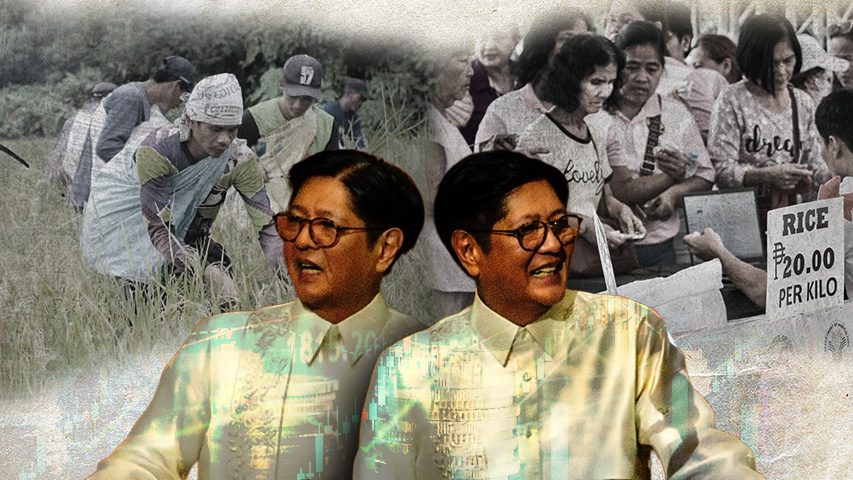Physical Address
304 North Cardinal St.
Dorchester Center, MA 02124
Physical Address
304 North Cardinal St.
Dorchester Center, MA 02124

It seems that Marcos can’t make up his mind. Does he want farmers to earn lots or not? His policies on this need to be clearer.
Just barely a week since the fourth State of the Nation Address (SONA) of President Ferdinand Marcos Jr., new data came out that gives us an updated picture of the state of the economy.
First off, domestic production grew by 5.5% in the second quarter of 2025, based on the growth of gross domestic product (GDP).
That’s the fastest growth rate over the past year, but still below the new (and lowered) growth target of Marcos’ economic managers. To reach the lower target of 5.5%, growth in the second half of the year must average 5.55%, which is not something to brag about.
Recall that growth used to hover above 6% before the pandemic. The latest growth figures show that attaining 6% is becoming more and more a pipe dream.
The good news is that faster growth stemmed from stronger consumer spending, particularly in food. It’s no coincidence that stronger food spending is happening just as inflation also reached a low of 0.9% in July 2025.
As I constantly teach my students at the UP School of Economics, a lower inflation rate doesn’t mean prices are dropping in general. It just means that they’re rising much more slowly now. In fact, 0.9% inflation is the lowest we’ve seen since 2019. It’s also lower than the 2-4% target range of the government. This suggests that, somehow, inflation now is rather too low.
Part of the reason is that the prices of some important components of the “basket of goods” (a set of consumer goods whose prices are closely monitored by government) have dropped recently.
The graph below shows that the contribution of food to overall inflation is almost zero, and transportation prices have been dropping since September 2024.
Rice prices, in particular, have dropped steadily since January 2025. President Marcos likes to credit the Department of Agriculture’s subsidies in the Kadiwa stores (he mentioned this in his State of the Nation Address). But in fact, a large part of this can be attributed to the big drop in global rice prices.
Another reason for the lower rice prices is the previous decision of Marcos to slash the rice tariff rate from 35% to 15% until 2018. Since importers need to pay less for their imports, the relative abundance of rice has pushed down prices.
But now, Marcos wants to reverse himself and suspend rice imports for 60 days, at the suggestion of Agriculture Secretary Francisco Tiu Laurel. You see, at the same time that lower rice prices are good news for consumers generally, it’s bad news for rice producers like farmers. Secretary Tiu Laurel said, “The stakes are high for both our farmers and the Filipino people, so it’s crucial that we strike the right balance.”
Apart from this, there’s a proposal from Senators Risa Hontiveros and Kiko Pangilinan to block the President from lowering rice tariffs unilaterally, also in an effort to help out farmers.
In the joint resolution they proposed, Hontiveros and Pangilinan said, “The plight of Filipino farmers is urgent and demands decisive legislative action to ensure they receive a fair return for their produce and to secure the nation’s food future by prioritizing domestic production over unchecked imports.”
These proposals are problematic for many reasons. They only make sense if politicians wish to make life harder for Filipinos who will have to pay higher rice prices. The proposals also contradict the previous reforms introduced by the Rice Tariffication Law: we need to lower rice tariffs rather than increase them.
By the way, remember that Marcos has long promised P20 per kilogram of rice at the retail? This is only possible if the price of rice at the farmgate is just around P10 per kilogram.
At this point, therefore, it seems that Marcos can’t make up his mind. Does he want rice to be cheap for consumers or not? Does he want farmers to earn lots or not? His policies on this need to be clearer.
Going back to the economy at large, it would appear that we’re now enjoying low inflation and decent growth — the best of both worlds. But there are many headwinds ahead.
For example, Trump’s tariffs are now in effect, and he’s planning 100% tariffs on semiconductors — a move that could prove devastating for our own semiconductor industry (the US is our largest export destination, and our largest export is semiconductors).
Inflation could also go up if global inflation goes up, what with Trump’s tariffs. Worse, global growth forecasts have been downgraded by the multilateral agencies.
Meanwhile, the 5.5% growth rate we got also won’t cut it if we wish to reduce the debt burden of the government. I peeked at the Treasury’s debt data, and as of June, the debt-to-GDP ratio is now at 63.1%, higher than the 62% in March.
What this means is that the debt ratio is steadily increasing — a red flag for the current and future administrations, and already enough to keep some economists awake at night. – Rappler.com
JC Punongbayan, PhD is an assistant professor at the UP School of Economics and the author of False Nostalgia: The Marcos “Golden Age” Myths and How to Debunk Them. In 2024, he received The Outstanding Young Men (TOYM) Award for economics. Follow him on Instagram (@jcpunongbayan).